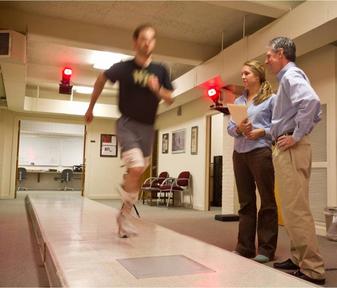I spent yesterday afternoon in the basement of the Runners Clinic at Reynolds Gymnasium at Wake Forest University, covered in sensors and belted into sci-fi like moving chairs. Why? I've been selected (i.e., my name was drawn from a hat) to participate in The Runners and Injury Longitudinal Study, or TRAILS study.
Contrary to what the acronym sounds like, there is no trail running involved. Instead:
Researchers at Wake Forest are using a $600,000 grant from the U.S. Army to try to determine the difference between runners who become injured and those who stay injury-free.
According to the university, running injuries are important to the U.S. Army because medical disability discharge rates have increased more than 600 percent in 25 years. Many of those discharges are caused by knee pain and other running-related injuries, such as medial tibial stress syndrome (shin splints), plantar fasciitis, Achilles tendinitis. (- Eddie Wooten, News & Record blog, April 15, 2011)
 Photo from News & Record
Photo from News & RecordThe study is testing running gait, flexibility and knee and ankle strength, so I spent a lot of time yesterday on a machine that had me pushing and pulling at the knee and ankle. The hard part (for Miss Control Freak here) is that there was nothing to judge against. It's not like at the gym where you can see how much weight you're lifting. In fact, the machine didn't even move on some of the tests. Instead, I was told that it would feel like I was pushing against a brick wall and to just push as hard as I could. So I had no idea if I was doing fair, well, outstanding, etc. Torture. ;)
I go back next Monday for a gait analysis. They'll hook me up to sensors and put me on their indoor running track that you see in the photo to the right. Height, weight and hip strength will also be measured. (Thank heavens I finally lost that cursed
7 lbs. Dropped the last of it right before the marathon. Let's hope it stays gone.)
After next Monday, I have to notify the staff of my injury status via e-mail every 2 weeks, injured or not. I also go back for 6 and 12 month follow-up visits or, if I'm injured during that time, they'll bring me in for assessment with the study's physician. I may be in the study for as long as two years.
They kind of expect runners on the study to become injured but I hope to prove them wrong. I'm a big believer in the low mileage/high intensity workout. Even during marathon training, I never went above 30 miles a week and most weeks I was right around 23-24 miles. Now that marathon season is over, I'll probably hang out in the 20-miles/ week range and try to add in more weight/yoga training.
Cheers,
Dena
 Photo from News & RecordThe study is testing running gait, flexibility and knee and ankle strength, so I spent a lot of time yesterday on a machine that had me pushing and pulling at the knee and ankle. The hard part (for Miss Control Freak here) is that there was nothing to judge against. It's not like at the gym where you can see how much weight you're lifting. In fact, the machine didn't even move on some of the tests. Instead, I was told that it would feel like I was pushing against a brick wall and to just push as hard as I could. So I had no idea if I was doing fair, well, outstanding, etc. Torture. ;)
Photo from News & RecordThe study is testing running gait, flexibility and knee and ankle strength, so I spent a lot of time yesterday on a machine that had me pushing and pulling at the knee and ankle. The hard part (for Miss Control Freak here) is that there was nothing to judge against. It's not like at the gym where you can see how much weight you're lifting. In fact, the machine didn't even move on some of the tests. Instead, I was told that it would feel like I was pushing against a brick wall and to just push as hard as I could. So I had no idea if I was doing fair, well, outstanding, etc. Torture. ;)





